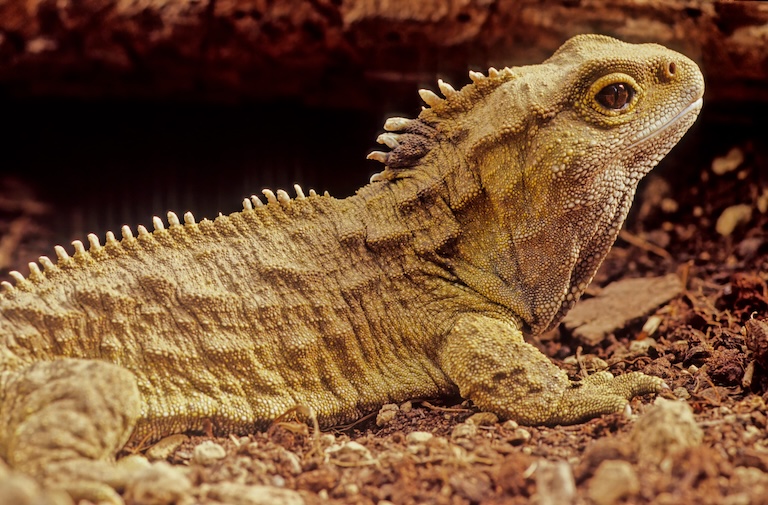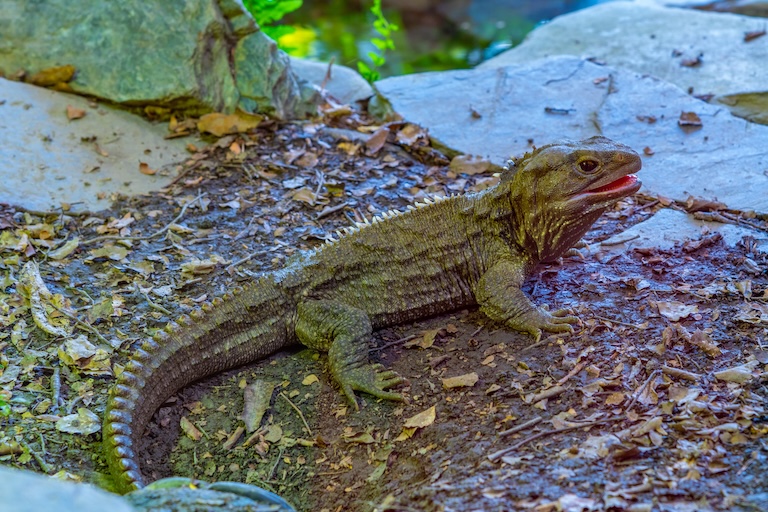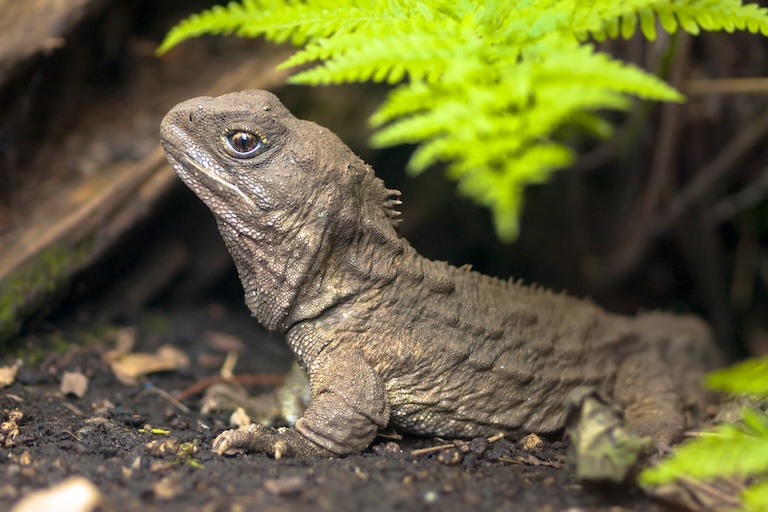Tuatara Profile
Being the “Largest reptile in New Zealand” is a bit like being the smartest cop in Texas, but statistical inevitability dictates there must be one, and in this case, it’s the Tuatara. A big lizard. And by big, we mean about 60 cm at best, and by lizard, we mean a unique and ancient lineage of reptile far more distantly related to lizards than you are to an echidna.

Tuatara Facts Overview
| Habitat: | Rocky, forested islands |
| Location: | New Zealand |
| Lifespan: | 60+ years |
| Size: | Around 60 cm (2 ft) long |
| Weight: | Around 600g |
| Colour: | Greenish brown to greyish blue |
| Diet: | Frogs |
| Predators: | Rats eat the eggs, humans poach them |
| Top Speed: | Unknown |
| No. of Species: | 1 |
| Conservation Status: | Least Concern |
Tuataras are very lizard-like. They look like a lizard, hunt like a lizard, regrow their tails like lizards, and they are reptiles, but they are a unique single species in an ancient order of mostly extinct reptiles that branched off from the ancestors of lizards, perhaps before the dinosaurs even showed up.
And they have a few weird things going for them as a result. They’re colder than your average reptile, slow to reproduce and can possibly see polarised light. This may look a bit like a carnivorous iguana, but it’s a fascinating relic from a forgotten past!
Interesting Tuatara Facts
1. They’re not Lizards
Reptiles are a funny bunch. Of all the classes of vertebrates, this one is probably the most out of date. And while scientists know more or less how to, the sheer weight of the job of updating all the paperwork would result in an epidemic of research assistants and interns calling in sick.
Because to get reptiles right, we’d have to get birds right, and now that we know birds are dinosaurs, and of course that dinosaurs were (are) reptiles, then birds are now also reptiles. But even if we remove birds for now, we’re still left with some exciting mysteries within Reptilia, and the Tuatara is one of the greatest.
For some background, there are four reptilian orders: the crocs and birds make up Archosauria; the lumbering shelled reptiles are the Testudines; the snakes and lizards are the Squamates; and the Tuatara is in the Rhinocephalia order.
This animal, despite how much its phenotype may insist, is not remotely a lizard. In fact, some estimates suggest that it diverged from the ancestors of lizards all the way back in the Permian.
Fossils of members of the Tuatara order, Rhyncocephalia, have been found in Early Triassic sediment, while lizards, and the Squamata order as a whole, can be found only as far back as the Middle Triassic, so the Tuatara line might be tens to hundreds of millions of years older than the lizard one.
By the end of the Triassic, Rhinocephalians were all over the world, but today, there is only one.

2. There is only one
It’s a sad state of affairs when there’s only a single species in an entire order of animals. Especially when that order once dominated a variety of terrestrial niches all over the world, but here we are.
The Tuatara is the single, last remaining species in an ancient order, and this is likely because squamates did things a lot better than they did. The Tuatara genome is enormous, which also might have something to do with it, as larger genomes tend to have a higher risk of extinction. For example, Iguanas, which look a lot like Tuataras, have about 2 billion DNA base pairs; Tuataras have over six billion!
But Iguanas are generally considered to be as dumb as a bag of hammers, and being so ancient must mean Tuataras have some incredible cosmic and spiritual secrets to share. For one thing, they have a third eye. 1
3. They have a third eye
This isn’t a unique feature in reptiles, or even vertebrates in general. Third, or Parietal eyes show up in frogs, lizards and fish, too, and so it’s probably an ancestral trait in the Tuatara that predates its separation from the squamates.
Regardless, tuataras have the most pronounced parietal eye of any reptile, clearly visible in hatchlings, and soon covered in thicker skin. This isn’t as acute in its sensory ability as the traditional eyes, and probably can’t see movement, but might be used for regulating melatonin and controlling sleep cycles.
It is also possible that the eye can perceive polarised light, as is the case in some salamanders, which would allow the animal to see where the sun is, even when it’s cloudy! 2
4. They can regrow their tails
Like many of their look-alike lizards, the tuatara can regenerate its tail when lost.3
This is not quite the level of regeneration we see in, say, geckos, who can miraculously regenerate spinal tissue, muscle, nerves and create brand new tails, it is far more than we can do, and in line with other reptiles like juvenile turtles and crocodilians. The process can take years and may not result in a perfect replacement.
5. They are cool
Tuataras are perhaps the last of their kind precisely because they can handle temperatures much lower than most reptiles.
In fact, they don’t do so well above 25 degrees Celsius, and prefer it relatively chilly, which New Zealand very much often is. So, this is a cold, cold reptile, compared with its squamate equivalents, and as you’d expect, it does things more slowly as a result.
Females only reproduce every four years, and while this is a chill approach to making babies, it also means they are vulnerable to eradication and slow to recover from population damage. 4
6. They went extinct
There were once thought to be two species of tuatara, but they were collapsed to just the one after genetic studies, and that’s the closest the tuatara ever got to having company in the time humans have known about it.
Even worse, introduced predators like rats drove the mainland population to extinction, leaving only a spattering of isolated populations on the smaller islands.
Fortunately, though, a reintroduction program on the mainland brought some back within the confines of a well-protected reserve, and now they do look like they might make a bit of a recovery, at least where they can be kept away from rats. 5

7. They’re back!
With this population, and the remaining small island ones, too, the species as a whole is considered of Least Concern by the IUCN.
As of 2019, there were estimated to be 55,000 mature individuals and enough genetic variation to keep their offspring from chewing the curtains for the foreseeable future.
Annoyingly, habitat loss and illegal capture still pose a serious threat, since this is a very slow-reproducing and very cool animal that people want to keep illegally. Some smaller populations do appear to be deteriorating in body condition, likely as a result of the lessening quality of forage. But at least, for now, the species isn’t in imminent danger. 6
Tuatara Fact-File Summary
Scientific Classification
| Kingdom: | Animalia |
| Phylum: | Chordata |
| Class: | Reptilia |
| Order: | Rhinocephalia |
| Family: | Sphenodontidae |
| Genus: | Sphenodon |
| Species Name: | Punctatis |
Fact Sources & References
- Koomgun et. al (2020), “Genome Complexity Reduction High-Throughput Genome Sequencing of Green Iguana (Iguana iguana) Reveal a Paradigm Shift in Understanding Sex-Chromosomal Linkages on Homomorphic X and Y Sex Chromosomes”, National Library of Medicine
- Malcolm Pullan (2024), “Tuatara – a three-eyed monster?”, Tiritiri Matangi.
- Alibardi et.al (2021), “Regeneration in Reptiles Generally and the New Zealand Tuatara in Particular as a Model to Analyse Organ Regrowth in Amniotes: A Review”, National Library of Medicine.
- Cree et. al (1992), “Reproductive cycles of male and female tuatara (Sphenodon punctatus) on Stephens Island, New Zealand”, Journal of Zoology.
- (2008), “Found: mainland NZ’s first tuatara nest in hundreds of years”,Zealandia.
- (2019), “Tuatara”, IUCN Red List.
